Visie op leermaterialen 2025
Download as pptx, pdf0 likes238 views
Ter gelegenheid van de Open Education Week 2021 op 2 maart gepresenteerd in webinar Visie op leermaterialen 2025
1 of 14
Download to read offline
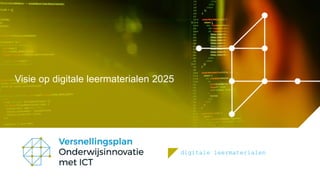
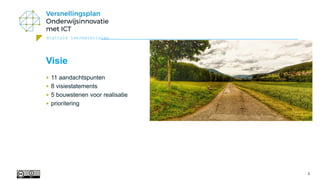
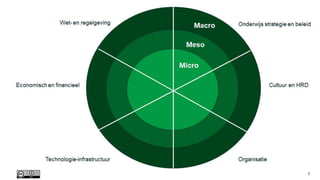
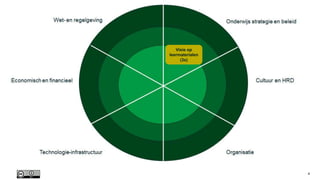

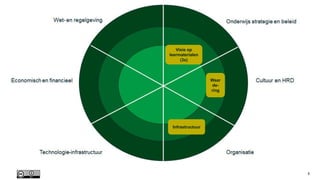
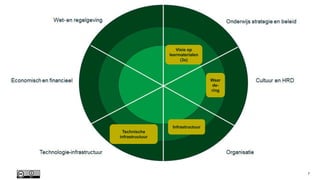
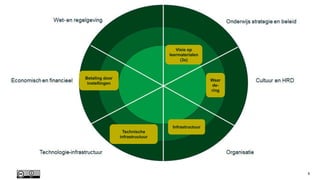
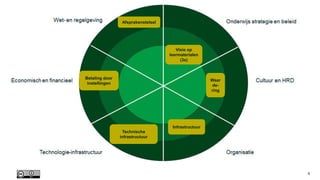


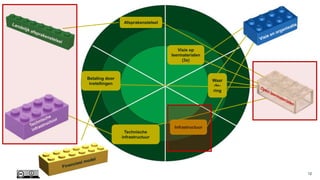
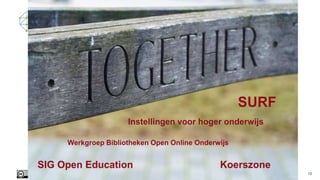
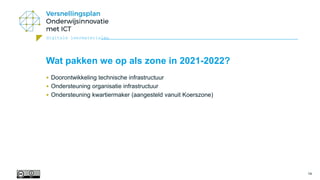
Ad
Recommended
Eindsymposium lectoraat OER
Eindsymposium lectoraat OERRobert Schuwer
Ěý
Slotlezing op symposium t.g.v. het afsluiten van mijn lectoraat 25-11-2022OER vanuit onderwijskundig perspectief
OER vanuit onderwijskundig perspectiefRobert Schuwer
Ěý
Workshop voor onderwijskundigen bij Fontys. 6-12-2022The Truth is Out There: Dutch Nursing realized sustainable adoption of OER
The Truth is Out There: Dutch Nursing realized sustainable adoption of OERRobert Schuwer
Ěý
The document discusses a national project in the Netherlands aimed at promoting the sharing of 1,900 open educational resources (OER) among nursing professionals across 17 universities, with over 200,000 nurses involved. It outlines the project's goals, methodology, and key findings from an analysis of factors influencing OER adoption, including management support and the importance of engaging early adopters. The document concludes with lessons learned and recommendations for future projects, emphasizing quality improvement and community sustainability.The Role of Brokers in Cultivating an Inter-Institutional Community around Op...
The Role of Brokers in Cultivating an Inter-Institutional Community around Op...Robert Schuwer
Ěý
The study investigates the role of brokers in fostering an inter-institutional community around open educational resources (OER) in higher education. It explores brokers' actions, the conflicts they face, and the overall impact on inter-institutional collaboration. Findings suggest that while brokers are crucial for community development, their role is complicated by conflicts and lack of support from management.Everything You Always Wanted To Know About OER
Everything You Always Wanted To Know About OERRobert Schuwer
Ěý
This document provides an overview of Open Educational Resources (OER). It defines OER as learning materials that can be freely accessed, reused, revised and redistributed. The document discusses the history of OER and policies around OER. It also covers practices for adopting OER and providing examples of OER cases. Throughout, it addresses common questions around OER, such as what rights users have, different license types, and barriers to sharing and reuse.Towards optimal benefiting from OER
Towards optimal benefiting from OERRobert Schuwer
Ěý
1) The document discusses research on optimizing the use of open educational resources (OER) by teachers. It outlines motivators and barriers for teachers in adopting OER.
2) Quality is identified as a key factor, and a quality model is proposed with criteria for OER content and design.
3) Two scenarios for OER use are described: a reading list and instruction model with more student agency. Support needs for teachers and students are noted.Framework for categorizing digital learning materials
Framework for categorizing digital learning materialsRobert Schuwer
Ěý
The document presents a framework for categorizing digital learning resources in higher education, particularly focusing on open educational resources (OER). It distinguishes various types of resources based on accessibility and adaptation rights, which aids in institutional policy formulation. The framework is an extension of an earlier model by David Wiley and serves to clarify the relationships among different educational materials.A process model of using digital (open) learning materials in teaching and le...
A process model of using digital (open) learning materials in teaching and le...Robert Schuwer
Ěý
The document presents a process model for using digital open learning materials in teaching and learning. The model includes context, learning outcomes, teaching/learning activities, assessment, constructive alignment, infrastructure, learning materials, and principles. It describes two scenarios - a reading list and instruction - and the support needed for teachers and students in each activity. The model aims to better determine the support and professionalization required when working with open educational resources.Dutch acceleration plan, the butterfly effect 2.0
Dutch acceleration plan, the butterfly effect 2.0Robert Schuwer
Ěý
The Dutch Acceleration Plan aims to have teachers and students easily determine and use their optimal mix of learning materials by 2023. In 2020, working groups supported change, stimulated reuse of open educational resources, and professionalized working with OER. A vision was developed for making optimal use of digital learning materials by 2025, with 11 focus areas and 8 vision statements. Five building blocks were proposed to realize the vision from 2020-2025, including developing nationwide infrastructure for teachers to find, create, edit, and share various forms of open and closed content. Suggestions are sought to improve the vision and ideas for the infrastructure.Naar een visie op open badges
Naar een visie op open badgesRobert Schuwer
Ěý
Presentatie Fontys leven lang ontwikkelen week 16-11-2020Everything you always wanted to know about Open Educational Resources (but we...
Everything you always wanted to know about Open Educational Resources (but we...Robert Schuwer
Ěý
Workshop Leiden University Medical Center (in Dutch) 11-2-2020Micro credentialing and open badges
Micro credentialing and open badgesRobert Schuwer
Ěý
This document discusses micro-credentialing and open badges. It explains that micro-credentials can recognize individual student achievements and help make unique learning pathways visible on certificates. Badges endorsed by third parties can provide recognition of skills, and institutions can further recognize badges by awarding credits. The document uses an example of a student earning an open badge from an online course who wants their university to recognize it for credit. Key questions are discussed around how institutions can determine the value of badges from unknown third parties and design an organizational "badge structure" to recognize informal learning through micro-credentials and open badges.A study on practices around reuse
A study on practices around reuseRobert Schuwer
Ěý
The document presents research on the practices of reuse of educational resources among teachers at Fontys School of ICT and the Nursing program. It reveals significant differences in the types and frequency of reused learning materials between the two programs, with ICT teachers exhibiting more reuse of third-party materials. Future plans include a national survey on OER reuse and the potential creation of an OER reuse hub.The butterfly effect: how connecting digital learning materials to the constr...
The butterfly effect: how connecting digital learning materials to the constr...Robert Schuwer
Ěý
This document outlines an innovation plan between Dutch higher education institutions to accelerate innovation in three shared ambitions: better job market connection, more flexible education, and smarter technology use. It focuses on developing digital and open learning materials. The plan runs from 2019-2023 and is funded with €3.8M annually. Regarding learning materials, the ambition is that by 2023 teachers and students can easily determine and use an optimal mix of materials. Actions include insight into optimal mixes, support models, a shared infrastructure, and greater open material sharing awareness. Results so far include studies on 2035 materials roles and current practices, as well as requirements for a sharing platform and an open pedagogy guide.Accelerating Educational Innovation of Dutch HE with ICT
Accelerating Educational Innovation of Dutch HE with ICTRobert Schuwer
Ěý
This document summarizes an innovation plan by the Association of Universities in the Netherlands to accelerate educational innovation using information and communication technology (ICT) in Dutch higher education from 2019 to 2023. The plan establishes eight zones focused on making education more flexible and connected to the job market, and using technology to improve learning. Each zone has a team that will collaborate across institutions on shared goals and receive €1.6 million in annual funding. One zone focuses on developing open digital learning materials, with goals of ensuring affordability, accessibility, and reuse of high-quality materials by 2023. Activities for 2019 include assessing how instructors and learners select learning materials, cataloging existing material repositories, creating a search engine, and sharingWorkshop kwaliteitsmodellen en keurmerken voor OER
Workshop kwaliteitsmodellen en keurmerken voor OERRobert Schuwer
Ěý
Presentatie tijdens de SURFAcademy workshop Kwaliteitsmodellen en keurmerken voor open leermateriaal. Utrecht, 20-6-2018SURF Netwerk Auteursrechten Informatiepunten 19-6-2018
SURF Netwerk Auteursrechten Informatiepunten 19-6-2018Robert Schuwer
Ěý
Presentatie over boegbeeldproject hbo Verpleegkunde voor het Netwerk Auteursrechten InformatiepuntenAdviesraad VO-Content 6-6-2018
Adviesraad VO-Content 6-6-2018Robert Schuwer
Ěý
Presentatie voor de Adviesraad van VO-Content, 6 juni 2018 in UtrechtPrepare TVET teachers for the digital future
Prepare TVET teachers for the digital futureRobert Schuwer
Ěý
This document discusses preparing TVET teachers for the digital future. It outlines several global trends including globalization, the rise of megacities, and new technologies that are influencing education. The document examines how ready teachers are to teach in the digital future and what skills they need, including technical skills to use new technologies, pedagogical skills to teach with and about new technologies, and strategic and organizational skills. It concludes that teachers must be aware of opportunities and challenges of new technologies to effectively prepare students.OER for TVET, an Odyssey
OER for TVET, an OdysseyRobert Schuwer
Ěý
This document summarizes key findings from a study on open educational resources (OER) for technical and vocational education and training (TVET) commissioned by UNESCO-UNEVOC. The study found that while OER have high relevance for TVET based on international declarations, there is surprisingly little research published on OER for TVET. Through a literature review and additional searches, the study only found a small number of publications discussing OER for TVET. This suggests that OER for TVET is an under-researched area that warrants further discussion and study.Open Educational Resources in Technical and Vocational Education and Training...
Open Educational Resources in Technical and Vocational Education and Training...Robert Schuwer
Ěý
The document discusses a study on the landscape of open educational resources (OER) in technical and vocational education and training (TVET), commissioned by UNESCO-UNEVOC. It reveals a lack of substantial research and uneven project development in OER for TVET, with many experts recognizing the potential benefits yet facing significant barriers to adoption. The findings underline the importance of broader access to resources and the need for an integrated approach to incorporate OER into educational ecosystems.Open onderwijs: doen of niet?
Open onderwijs: doen of niet?Robert Schuwer
Ěý
ICTO-symposium Saxion Delen open leermaterialen 15-3-2018Open onderwijs en Bildung
Open onderwijs en BildungRobert Schuwer
Ěý
Fontys Academy Studiesucces 19-12-2017 Eindhoven. Kansen van open onderwijs voor de Bildungs opdracht van hoger onderwijsOpen online onderwijs, kansen voor verbinding van de opleiding met het werkveld
Open online onderwijs, kansen voor verbinding van de opleiding met het werkveldRobert Schuwer
Ěý
Presentatie voor delegatie Brainport Eindhoven. 7-12-2017
Evaluating OER
Evaluating OERRobert Schuwer
Ěý
This document discusses experiences with evaluating open educational resources (OER) in the Netherlands. It describes Wikiwijs, a national OER platform launched in 2009 to develop and share OER. Wikiwijs now hosts over 1.6 million OER building blocks and 48,000 lessons. The document then discusses using quality marks assigned by peer review or organizations to help teachers identify high-quality OER. It notes that teachers find quality marks more reliable than ratings, and that transparency is important to build trust. Finally, it shares that teachers report the presence of a quality mark is more important than which specific mark is used.OER in Technical Vocational Education and Training (TVET)
OER in Technical Vocational Education and Training (TVET)Robert Schuwer
Ěý
The study on open educational resources (OER) in technical and vocational education and training (TVET) identifies significant gaps in awareness and adoption across various countries and highlights the potential of OER to enhance access, quality, and efficiency in education. Key challenges include inadequate ICT skills among educators and the need for effective capacity-building programs, while recommendations suggest embedding OER initiatives within broader educational policies and frameworks. The research underscores the importance of collaboration among stakeholders to foster an ecosystem that supports the integration of OER into TVET.Inspiratiedag bibliotheken SURF 29 3-2017
Inspiratiedag bibliotheken SURF 29 3-2017Robert Schuwer
Ěý
Inspiratiedag bibliotheken SURF 29-3-2017. Onderzoek naar adoptie van OERMultivariable Calculus 2nd Edition Brian E. Blank
Multivariable Calculus 2nd Edition Brian E. Blankvcoxhiq738
Ěý
Multivariable Calculus 2nd Edition Brian E. Blank
Multivariable Calculus 2nd Edition Brian E. Blank
Multivariable Calculus 2nd Edition Brian E. BlankThe Ongoing Technological System Ait El Hadj Smal
The Ongoing Technological System Ait El Hadj Smalbhfekrzdq718
Ěý
The Ongoing Technological System Ait El Hadj Smal
The Ongoing Technological System Ait El Hadj Smal
The Ongoing Technological System Ait El Hadj SmalMore Related Content
More from Robert Schuwer (20)
Dutch acceleration plan, the butterfly effect 2.0
Dutch acceleration plan, the butterfly effect 2.0Robert Schuwer
Ěý
The Dutch Acceleration Plan aims to have teachers and students easily determine and use their optimal mix of learning materials by 2023. In 2020, working groups supported change, stimulated reuse of open educational resources, and professionalized working with OER. A vision was developed for making optimal use of digital learning materials by 2025, with 11 focus areas and 8 vision statements. Five building blocks were proposed to realize the vision from 2020-2025, including developing nationwide infrastructure for teachers to find, create, edit, and share various forms of open and closed content. Suggestions are sought to improve the vision and ideas for the infrastructure.Naar een visie op open badges
Naar een visie op open badgesRobert Schuwer
Ěý
Presentatie Fontys leven lang ontwikkelen week 16-11-2020Everything you always wanted to know about Open Educational Resources (but we...
Everything you always wanted to know about Open Educational Resources (but we...Robert Schuwer
Ěý
Workshop Leiden University Medical Center (in Dutch) 11-2-2020Micro credentialing and open badges
Micro credentialing and open badgesRobert Schuwer
Ěý
This document discusses micro-credentialing and open badges. It explains that micro-credentials can recognize individual student achievements and help make unique learning pathways visible on certificates. Badges endorsed by third parties can provide recognition of skills, and institutions can further recognize badges by awarding credits. The document uses an example of a student earning an open badge from an online course who wants their university to recognize it for credit. Key questions are discussed around how institutions can determine the value of badges from unknown third parties and design an organizational "badge structure" to recognize informal learning through micro-credentials and open badges.A study on practices around reuse
A study on practices around reuseRobert Schuwer
Ěý
The document presents research on the practices of reuse of educational resources among teachers at Fontys School of ICT and the Nursing program. It reveals significant differences in the types and frequency of reused learning materials between the two programs, with ICT teachers exhibiting more reuse of third-party materials. Future plans include a national survey on OER reuse and the potential creation of an OER reuse hub.The butterfly effect: how connecting digital learning materials to the constr...
The butterfly effect: how connecting digital learning materials to the constr...Robert Schuwer
Ěý
This document outlines an innovation plan between Dutch higher education institutions to accelerate innovation in three shared ambitions: better job market connection, more flexible education, and smarter technology use. It focuses on developing digital and open learning materials. The plan runs from 2019-2023 and is funded with €3.8M annually. Regarding learning materials, the ambition is that by 2023 teachers and students can easily determine and use an optimal mix of materials. Actions include insight into optimal mixes, support models, a shared infrastructure, and greater open material sharing awareness. Results so far include studies on 2035 materials roles and current practices, as well as requirements for a sharing platform and an open pedagogy guide.Accelerating Educational Innovation of Dutch HE with ICT
Accelerating Educational Innovation of Dutch HE with ICTRobert Schuwer
Ěý
This document summarizes an innovation plan by the Association of Universities in the Netherlands to accelerate educational innovation using information and communication technology (ICT) in Dutch higher education from 2019 to 2023. The plan establishes eight zones focused on making education more flexible and connected to the job market, and using technology to improve learning. Each zone has a team that will collaborate across institutions on shared goals and receive €1.6 million in annual funding. One zone focuses on developing open digital learning materials, with goals of ensuring affordability, accessibility, and reuse of high-quality materials by 2023. Activities for 2019 include assessing how instructors and learners select learning materials, cataloging existing material repositories, creating a search engine, and sharingWorkshop kwaliteitsmodellen en keurmerken voor OER
Workshop kwaliteitsmodellen en keurmerken voor OERRobert Schuwer
Ěý
Presentatie tijdens de SURFAcademy workshop Kwaliteitsmodellen en keurmerken voor open leermateriaal. Utrecht, 20-6-2018SURF Netwerk Auteursrechten Informatiepunten 19-6-2018
SURF Netwerk Auteursrechten Informatiepunten 19-6-2018Robert Schuwer
Ěý
Presentatie over boegbeeldproject hbo Verpleegkunde voor het Netwerk Auteursrechten InformatiepuntenAdviesraad VO-Content 6-6-2018
Adviesraad VO-Content 6-6-2018Robert Schuwer
Ěý
Presentatie voor de Adviesraad van VO-Content, 6 juni 2018 in UtrechtPrepare TVET teachers for the digital future
Prepare TVET teachers for the digital futureRobert Schuwer
Ěý
This document discusses preparing TVET teachers for the digital future. It outlines several global trends including globalization, the rise of megacities, and new technologies that are influencing education. The document examines how ready teachers are to teach in the digital future and what skills they need, including technical skills to use new technologies, pedagogical skills to teach with and about new technologies, and strategic and organizational skills. It concludes that teachers must be aware of opportunities and challenges of new technologies to effectively prepare students.OER for TVET, an Odyssey
OER for TVET, an OdysseyRobert Schuwer
Ěý
This document summarizes key findings from a study on open educational resources (OER) for technical and vocational education and training (TVET) commissioned by UNESCO-UNEVOC. The study found that while OER have high relevance for TVET based on international declarations, there is surprisingly little research published on OER for TVET. Through a literature review and additional searches, the study only found a small number of publications discussing OER for TVET. This suggests that OER for TVET is an under-researched area that warrants further discussion and study.Open Educational Resources in Technical and Vocational Education and Training...
Open Educational Resources in Technical and Vocational Education and Training...Robert Schuwer
Ěý
The document discusses a study on the landscape of open educational resources (OER) in technical and vocational education and training (TVET), commissioned by UNESCO-UNEVOC. It reveals a lack of substantial research and uneven project development in OER for TVET, with many experts recognizing the potential benefits yet facing significant barriers to adoption. The findings underline the importance of broader access to resources and the need for an integrated approach to incorporate OER into educational ecosystems.Open onderwijs: doen of niet?
Open onderwijs: doen of niet?Robert Schuwer
Ěý
ICTO-symposium Saxion Delen open leermaterialen 15-3-2018Open onderwijs en Bildung
Open onderwijs en BildungRobert Schuwer
Ěý
Fontys Academy Studiesucces 19-12-2017 Eindhoven. Kansen van open onderwijs voor de Bildungs opdracht van hoger onderwijsOpen online onderwijs, kansen voor verbinding van de opleiding met het werkveld
Open online onderwijs, kansen voor verbinding van de opleiding met het werkveldRobert Schuwer
Ěý
Presentatie voor delegatie Brainport Eindhoven. 7-12-2017
Evaluating OER
Evaluating OERRobert Schuwer
Ěý
This document discusses experiences with evaluating open educational resources (OER) in the Netherlands. It describes Wikiwijs, a national OER platform launched in 2009 to develop and share OER. Wikiwijs now hosts over 1.6 million OER building blocks and 48,000 lessons. The document then discusses using quality marks assigned by peer review or organizations to help teachers identify high-quality OER. It notes that teachers find quality marks more reliable than ratings, and that transparency is important to build trust. Finally, it shares that teachers report the presence of a quality mark is more important than which specific mark is used.OER in Technical Vocational Education and Training (TVET)
OER in Technical Vocational Education and Training (TVET)Robert Schuwer
Ěý
The study on open educational resources (OER) in technical and vocational education and training (TVET) identifies significant gaps in awareness and adoption across various countries and highlights the potential of OER to enhance access, quality, and efficiency in education. Key challenges include inadequate ICT skills among educators and the need for effective capacity-building programs, while recommendations suggest embedding OER initiatives within broader educational policies and frameworks. The research underscores the importance of collaboration among stakeholders to foster an ecosystem that supports the integration of OER into TVET.Inspiratiedag bibliotheken SURF 29 3-2017
Inspiratiedag bibliotheken SURF 29 3-2017Robert Schuwer
Ěý
Inspiratiedag bibliotheken SURF 29-3-2017. Onderzoek naar adoptie van OERRecently uploaded (11)
Multivariable Calculus 2nd Edition Brian E. Blank
Multivariable Calculus 2nd Edition Brian E. Blankvcoxhiq738
Ěý
Multivariable Calculus 2nd Edition Brian E. Blank
Multivariable Calculus 2nd Edition Brian E. Blank
Multivariable Calculus 2nd Edition Brian E. BlankThe Ongoing Technological System Ait El Hadj Smal
The Ongoing Technological System Ait El Hadj Smalbhfekrzdq718
Ěý
The Ongoing Technological System Ait El Hadj Smal
The Ongoing Technological System Ait El Hadj Smal
The Ongoing Technological System Ait El Hadj SmalRECENT DEVELOPMENTS IN BIOENERGY RESEARCH Vijai G. Gupta (Editor)
RECENT DEVELOPMENTS IN BIOENERGY RESEARCH Vijai G. Gupta (Editor)hsakvtrw562
Ěý
RECENT DEVELOPMENTS IN BIOENERGY RESEARCH Vijai G. Gupta (Editor)
RECENT DEVELOPMENTS IN BIOENERGY RESEARCH Vijai G. Gupta (Editor)
RECENT DEVELOPMENTS IN BIOENERGY RESEARCH Vijai G. Gupta (Editor)Concepts in Strategic Management and Business Policy Globalization Innovation...
Concepts in Strategic Management and Business Policy Globalization Innovation...ewlalgp855
Ěý
Concepts in Strategic Management and Business Policy Globalization Innovation and Sustainability 15th Edition Wheelen Solutions Manual
Concepts in Strategic Management and Business Policy Globalization Innovation and Sustainability 15th Edition Wheelen Solutions Manual
Concepts in Strategic Management and Business Policy Globalization Innovation and Sustainability 15th Edition Wheelen Solutions ManualSociology A Down to Earth Approach 13th Edition Henslin Test Bank
Sociology A Down to Earth Approach 13th Edition Henslin Test Bankssdygsoq114
Ěý
Sociology A Down to Earth Approach 13th Edition Henslin Test Bank
Sociology A Down to Earth Approach 13th Edition Henslin Test Bank
Sociology A Down to Earth Approach 13th Edition Henslin Test BankThe Making Of Gratians Decretum 1st Edition Anders Winroth
The Making Of Gratians Decretum 1st Edition Anders Winrothkutuskaine
Ěý
The Making Of Gratians Decretum 1st Edition Anders Winroth
The Making Of Gratians Decretum 1st Edition Anders Winroth
The Making Of Gratians Decretum 1st Edition Anders WinrothThe Psychology of Spine Surgery 1st Edition Andrew R. Block
The Psychology of Spine Surgery 1st Edition Andrew R. Blockugcrokz061
Ěý
The Psychology of Spine Surgery 1st Edition Andrew R. Block
The Psychology of Spine Surgery 1st Edition Andrew R. Block
The Psychology of Spine Surgery 1st Edition Andrew R. BlockA New Architecture For Functional Grammar Functional Grammar Series J Lachlan...
A New Architecture For Functional Grammar Functional Grammar Series J Lachlan...ecnlxfkyv5483
Ěý
A New Architecture For Functional Grammar Functional Grammar Series J Lachlan Mackenzie
A New Architecture For Functional Grammar Functional Grammar Series J Lachlan Mackenzie
A New Architecture For Functional Grammar Functional Grammar Series J Lachlan MackenzieComparative Genomics Methods And Protocols 1st Edition Joo C Setubal
Comparative Genomics Methods And Protocols 1st Edition Joo C Setubalxbhamef758
Ěý
Comparative Genomics Methods And Protocols 1st Edition Joo C Setubal
Comparative Genomics Methods And Protocols 1st Edition Joo C Setubal
Comparative Genomics Methods And Protocols 1st Edition Joo C SetubalThe data warehouse toolkit the complete guide to dimensional modeling 2nd ed ...
The data warehouse toolkit the complete guide to dimensional modeling 2nd ed ...misjzdqlx0124
Ěý
The data warehouse toolkit the complete guide to dimensional modeling 2nd ed Edition Ralph Kimball
The data warehouse toolkit the complete guide to dimensional modeling 2nd ed Edition Ralph Kimball
The data warehouse toolkit the complete guide to dimensional modeling 2nd ed Edition Ralph KimballFoodborne Disease Handbook. Volume 2: Viruses, Parasites, Pathogens, and HACC...
Foodborne Disease Handbook. Volume 2: Viruses, Parasites, Pathogens, and HACC...axswigb793
Ěý
Foodborne Disease Handbook. Volume 2: Viruses, Parasites, Pathogens, and HACCP Y. H. Hui
Foodborne Disease Handbook. Volume 2: Viruses, Parasites, Pathogens, and HACCP Y. H. Hui
Foodborne Disease Handbook. Volume 2: Viruses, Parasites, Pathogens, and HACCP Y. H. HuiAd
Visie op leermaterialen 2025
- 1. digitale leermaterialen Visie op digitale leermaterialen 2025
- 2. digitale leermaterialen 2 Visie • 11 aandachtspunten • 8 visiestatements • 5 bouwstenen voor realisatie • prioritering
- 8. digitale leermaterialen 8 Visie op leermaterialen (3x) Waar de- ring Infrastructuur Technische infrastructuur Betaling door instellingen
- 9. digitale leermaterialen 9 Visie op leermaterialen (3x) Waar de- ring Infrastructuur Technische infrastructuur Betaling door instellingen Afsprakenstelsel
- 10. digitale leermaterialen 10 Vijf bouwstenen • Van IST naar SOLL • Iedere bouwsteen – Adresseert één of meer visiestatements – Raakt aan één of meer uitgangspunten
- 11. digitale leermaterialen 11 Visie op leermaterialen (3x) Infrastructuur Technische infrastructuur Betaling door instellingen Afsprakenstelsel Waar de- ring
- 12. digitale leermaterialen 12 Visie op leermaterialen (3x) Infrastructuur Technische infrastructuur Betaling door instellingen Afsprakenstelsel Waar de- ring
- 14. digitale leermaterialen 14 Wat pakken we op als zone in 2021-2022? • Doorontwikkeling technische infrastructuur • Ondersteuning organisatie infrastructuur • Ondersteuning kwartiermaker (aangesteld vanuit Koerszone)
